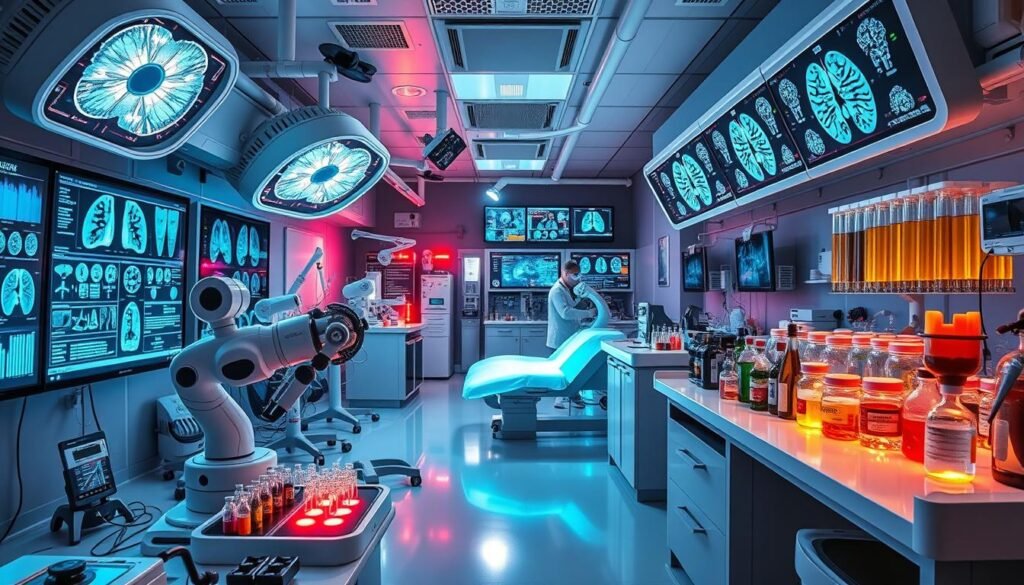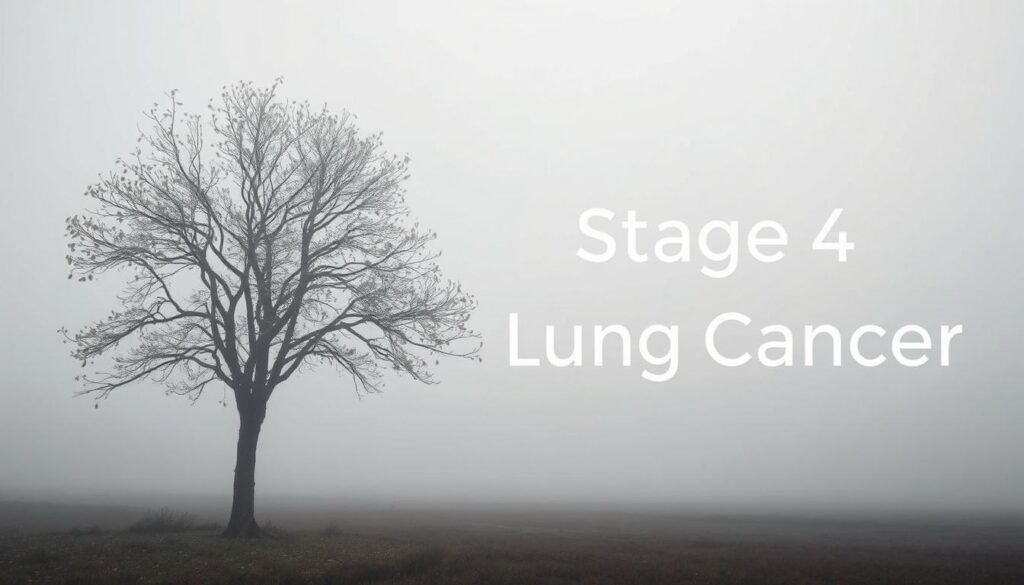The five-year relative survival rate for stage 4 lung cancer is just 7 percent. This stark number shows the tough battle faced by those with advanced lung cancer. At the terminal stage, the cancer has spread far beyond the lungs. This calls for a treatment approach that combines chemotherapy, targeted therapies, and palliative care. It’s key for patients and caregivers to understand these options.
Today’s advancements in therapies are creating hope for better outcomes and life quality. Chemotherapy for late-stage lung cancer mainly aims to ease symptoms and improve comfort. But, with new research and treatments being developed, the fight against advanced lung cancer is evolving. We’ll look into how chemotherapy works, current treatments, and how genetic testing can tailor care for those affected.
Key Takeaways
- Stage 4 lung cancer indicates widespread disease, making treatment challenging.
- The five-year survival rate for metastatic lung cancer is alarmingly low at just 7 percent.
- Recent advances in treatment options are increasing quality of life for patients.
- Chemotherapy is critical in managing symptoms for late-stage lung cancer patients.
- Genetic testing can significantly inform personalized treatment plans.
- Palliative care plays an essential role alongside standard treatments.
- Understanding treatment options empowers patients and their families during traumatic times.
Understanding Stage 4 Lung Cancer
Stage 4 lung cancer is the most severe form, spreading to places like the liver, brain, or bones. It shows through signs such as continuous coughing, chest pain, and weight loss. Knowing these symptoms early is key for getting proper care fast.
What Comprises Stage 4 Lung Cancer?
Stage 4 lung cancer includes non-small cell (NSCLC) and small cell (SCLC) types. NSCLC makes up about 85 to 90 percent of these cancers and has two advanced stages: 4A and 4B. The TNM system, which stands for Tumour, Node, and Metastasis, helps classify the disease’s reach.
For advanced non-small cell lung cancer with wide spread, the survival rate over five years is about 8 percent. If the spread is more local, survival increases to 37 percent. Small cell lung cancer has a 3 percent survival rate when spread widely, and 18 percent if it’s more localized.
Understanding stage 4 lung cancer shows why it’s important to look into treatment options. Treatments aim to control the spread and ease symptoms. These may include chemotherapy, immunotherapy, and targeted therapies. More on treatments can be found here.
What is Chemotherapy for Late Stage Lung Cancer?
Chemotherapy is key for treating stage 4 lung cancer. This method uses strong drugs to destroy fast-growing cancer cells. Given in cycles, this therapy aims to alleviate symptoms and may increase survival times. Knowing the available chemo options is crucial for understanding the treatment of stage 4 lung cancer.
The Role of Chemotherapy
Chemotherapy’s main aim for late stage lung cancer is to slow down the disease. It often starts with these drug pairs:
- Cisplatin and etoposide
- Carboplatin and etoposide
If the first round doesn’t work, doctors might try other drugs like topotecan, lurbinectedin, and docetaxel. In metastatic non-small cell lung cancer, treatment combines chemo with immunotherapy. Drugs such as pembrolizumab or bevacizumab are examples.
Typically, treatment involves four to six cycles to let the body rest in between. Treatment happens in day clinics or hospitals, based on the regimen and the patient’s condition.
| Chemotherapy Drugs | Indication |
|---|---|
| Cisplatin | Used in combination therapies for small cell lung cancer |
| Etoposide | Part of standard regimens for small cell lung cancer |
| Topotecan | Recommended if initial treatment fails |
| Docetaxel | Utilized in advanced lung cancer treatments |
| Pemetrexed | Common in non-small cell lung cancer treatment plans |
| Paclitaxel | Administered as part of combination treatments |
Chemotherapy can be tough. Side effects like hair loss, fatigue, and a higher risk of infection can occur. Managing these effects is vital and requires support from healthcare professionals. It highlights the need for thorough care during stage 4 lung cancer treatment.
Stage 4 Lung Cancer Chemo: Treatment Insights
Stage 4 lung cancer is a critical point in the disease, needing a detailed treatment plan. Doctors now use the latest medical discoveries to choose the best chemo. They look at the tumor’s unique features, like genetic changes, to find the most effective therapy.
Supportive therapies also play a big part in making chemo for stage 4 lung cancer work better.
Current Chemotherapy Protocols
Treatment for advanced lung cancer has grown a lot, with plans aimed at the patient’s specific situation. Nowadays, the best chemo plans mix classic drugs, new targeted therapies, and immunotherapies. These approaches help control symptoms and could lead to longer survival.
- Palliative care can be integrated during initial diagnosis to manage symptoms effectively.
- Gene mutations such as KRAS, EGFR, ALK, and others provide targets for advanced lung cancer treatment.
- Immunotherapy may be particularly beneficial for tumors expressing higher levels of PD-L1.
- Combination therapies, using both chemotherapy and targeted approaches, are increasingly popular in treating stage 4 lung cancers.
Chemo treatments are getting better and easier to handle with supportive therapies. Practices like meditation and yoga offer relief from the stress of treatment. This helps improve life quality.
Also, ongoing clinical trials bring new hopes. They give patients access to cutting-edge treatments not widely available yet.
Advanced Lung Cancer Treatment Options
Lung cancer treatments have grown far beyond just chemo. Doctors now use a mix of methods to fight cancer more effectively. They combine different therapies to boost success rates and help patients feel better.
Combining Therapies for Better Outcomes
Doctors see that stage 4 lung cancer is different for everyone. Treatment plans consider your health and how your cancer acts. They use many methods to try and beat the cancer.
- Targeted Therapies: These treatments attack specific parts of cancer cells. Drugs like erlotinib and crizotinib are used to tailor treatment to each patient.
- Immunotherapy: This boosts your immune system to fight cancer. It’s key for those who might not do well with chemo.
- Palliative Treatments: Treatments aim to reduce symptoms and make life better. They’re essential for caring for stage 4 lung cancer patients.
- Clinical Trials: Joining these can give you access to new treatments. They look for better ways to combine current therapies to increase survival.
A team of doctors will review your case to find the best treatment. They consider the type of cancer, your symptoms, and what you prefer. This ensures you get a plan that fits just right.

| Type of Treatment | Purpose | Example Drugs/Methods |
|---|---|---|
| Targeted Therapy | Focuses on specific cancer markers | ERLOTINIB, CRIZOTINIB |
| Immunotherapy | Activates the immune system against cancer | KEYTRUDA, OPDIVO |
| Palliative Treatment | Manages symptoms and improves quality of life | Radiation Therapy, SBRT |
| Clinical Trials | Explores new treatment combinations | Investigational drugs |
These new treatments give hope and may help patients live longer. When patients and doctors work together, they can find the best way to fight stage 4 lung cancer.
Targeted Therapy for Advanced Lung Cancer
Targeted therapy for advanced lung cancer focuses on the cancer cells’ unique mutations. It helps patients with mutations like KRAS, EGFR, and ALK. These therapies target the growth and spread of tumors differently from traditional chemotherapy.
Mechanisms of Action and Benefits
Targeted therapy drugs aim at DNA errors causing cell proliferation. Erlotinib and crizotinib are FDA-approved and focus on EGFR and ALK mutations. Compared to chemotherapy, targeted therapies usually have fewer side effects. They mainly attack cancer cells, sparing healthy ones.
- Tyrosine kinase inhibitors (available in pill form)
- Antibody-drug conjugates (delivered via IV)
- Angiogenesis inhibitors (delivered via IV)
Biomarker testing, like next-generation sequencing (NGS), identifies patients for targeted therapy. Not everyone is a candidate. Some may use other treatments or join clinical trials. EGFR-targeted therapy, for instance, improves life quality. It works better than chemotherapy for treating EGFR-positive non-small cell lung cancers by delaying cancer progression.
Current treatments include:
| Mutation Type | Targeted Therapy Example | Mechanism |
|---|---|---|
| KRAS | Sotorasib (Lumakras) | Inhibits KRAS G12C mutations |
| ALK | Crizotinib | Inhibitor of ALK fusion proteins |
| EGFR | Erlotinib | Targets EGFR mutations |
| BRAF V600E | Dabrafenib and Trametinib | Inhibit BRAF V600E mutations |
| TRK Fusion | Larotrectinib | Targets TRK fusion proteins |
Targeted therapies represent a huge step forward for treating advanced lung cancer. They offer specialized care that can help patients and their families make informed choices. For more on targeted therapies, visit this resource.
Innovative Treatments for Late Stage Lung Cancer
New treatments bring hope for late-stage lung cancer patients. These include gene editing, custom immunotherapy, and flexible plans based on how well a patient responds. This is changing cancer care and helping people live longer.
Novel Approaches in Therapy
One exciting update is using genetics to tailor treatments. Drugs like sotorasib (Lumakras™) are now used for certain lung cancers. They specifically fight cancers with KRAS mutations. Also, drugs that help the immune system attack cancer are a key part of starting treatments.
New drug combinations are being tested in clinical trials. For some patients, doctors use a special method called intrathecal chemotherapy. This targets cancer in a precise way, while patients can still receive other treatments.
Talking about treatment options with doctors is crucial for those facing advanced lung cancer. This team effort ensures treatments meet the needs of both mind and body.

| Treatment Option | Description | Indication |
|---|---|---|
| KRAS-targeting therapy | Targeted drug therapy such as sotorasib that focuses on specific mutations | For non-small cell lung cancer with KRAS mutations |
| Checkpoint Inhibitors | Boosts the immune system’s response to cancer | Used as an initial treatment for various types of lung cancer |
| Intrathecal Chemotherapy | Direct administration of chemotherapy into the cerebrospinal fluid | For managing leptomeningeal disease in selected patients |
| Ommaya Reservoir | A device that allows repeated access to cerebrospinal fluid | Facilitates intrathecal chemotherapy while maintaining systemic therapies |
The growth of these therapies shows a dedication to improving care for advanced lung cancer patients. With ongoing research, the future of treatment looks bright, promising even more improvements.
Understanding Side Effects of Stage 4 Lung Cancer Treatment
Stage 4 lung cancer treatment has side effects that can concern patients. It’s aimed at improving health and survival. Knowing these side effects is important for managing them well.
Managing Treatment Side Effects
Chemotherapy can cause various side effects. These include feeling tired, nausea, thin hair, and being more likely to get infections. Each person’s side effects vary with the type of chemotherapy used.
It’s critical to monitor for treatment issues through blood tests. These tests check blood cells and how the liver and kidneys are doing. Staying hydrated is important to avoid kidney damage. Some side effects might worsen during treatment and stay for weeks or months after it ends.
Other side effects are:
- Breathlessness and losing appetite
- Numbness in fingers or toes that can last months
- Taste changes or difficulty swallowing
- Bruising and bleeding gums as signs of low platelets
- Constipation, eased by diet and staying hydrated
Keeping up with calories is key when treatment lowers appetite and causes weight loss. Sometimes, patients need platelet transfusions for low platelet counts from chemotherapy. Talking with healthcare teams helps find ways to deal with these side effects.
For more on handling non-small cell lung cancer chemotherapy side effects, check out supportive care and treatment plans at chemotherapy information from the American Cancer Society.
Stage 4 Lung Cancer Prognosis and Survival Rates
For patients and families, knowing about stage 4 lung cancer is key. This stage means the cancer has spread beyond the lungs. This affects the treatments and outcomes. The patient’s health, cancer mutations, and treatment response are big factors in their prognosis.
Factors Influencing Prognosis
The five-year survival rate for this stage of lung cancer is quite low, about 5% to 10%. Studies show the median survival is 11.4 months. However, for certain patients, it’s around 6.3 months. Even faced with tough stats, new treatments bring hope.
- One-year survival rates vary from 15% to 19%.
- People under 50 have a five-year survival rate of 14.2%, while it’s only 5.6% for those over 65.
- Women have a slightly better five-year survival rate of 8.6% compared to men’s 5.6%.
- Performance status influences survival too. An ECOG score of 0 means a 45.9% survival rate, which drops with higher scores.
- The type of non-small cell lung cancer makes a difference as well, with lung adenocarcinoma at 20.6%, squamous cell carcinoma at 17.6%, and large cell carcinoma at 13.2%.
The outcomes for stage 4 lung cancer depend on many things. Early action, genetic tests, and tailored treatments can help patients do better.

| Category | Five-Year Survival Rate |
|---|---|
| Overall for Stage 4 Lung Cancer | 5% – 10% |
| Age Under 50 | 14.2% |
| Age 65 and Older | 5.6% |
| Women | 8.6% |
| Men | 5.6% |
| ECOG Performance Status 0 | 45.9% |
| ECOG Performance Status 1 | 18.7% |
| ECOG Performance Status 2 | 5.8% |
The Role of Genetics in Stage 4 Lung Cancer Treatment
Knowing how genetics affects stage 4 lung cancer is key to creating better treatments. By doing genomic testing, doctors can find specific mutations in tumors. This leads to personalized treatments that can really help patients by targeting the cancer more effectively.
This approach not only helps in fighting the cancer but also in reducing side effects. It’s all about making treatment plans that fit the patient’s unique genetic makeup.
Genomic Testing for Personalized Treatment
There are many tests used to spot the genetic changes linked to lung cancer. Consider Sara Whitlock’s story. Given only a 3 percent survival rate over five years for stage 4 non-small cell lung cancer, targeted therapies have been a game-changer for her. She’s had great results from a trial drug named selpercatinib (LOXO-292).
This medication is meant for certain mutations and gives hope to those with rare lung cancers. For example, 10-15% of lung adenocarcinomas have EGFR mutations, and ALK rearrangements affect 3-7% of cases. The therapies targeting these mutations are transforming cancer treatment into something more manageable over time.
Studies show that clinical trials using genomic testing improve patient life expectancy. These trials indicate that treatments tailored to a patient’s genes can have big benefits. Also, many patients only see mild side effects.
Thus, doctors are turning their attention to long-term care. They aim to help patients live longer than what was once expected.
| Genetic Alteration | Prevalence | Commonly Used Targeted Therapies |
|---|---|---|
| EGFR Mutations | 10-15% | Erlotinib, Gefitinib, Afatinib |
| ALK Rearrangements | 3-7% | Crizotinib |
| ROS1 Rearrangements | 1-2% | Crizotinib |
| BRAF Mutations | 2-4% | Vemurafenib, Trametinib |
| RET Fusions | 1-2% | Cabozantinib, Vandetanib |
| KRAS Mutations | 20% | Selumetinib |
Conclusion
Dealing with stage 4 lung cancer chemo can feel overwhelming for patients and families. But learning about different treatment methods offers some hope. Treatments like chemotherapy, targeted therapies, and new approaches can really help. Thanks to advances in care and research, those with advanced lung cancer now have better, more personalized options. This can greatly improve survival rates.
Having a strong support system is crucial for anyone facing stage IV lung cancer. It’s vital to speak openly with doctors about treatment options, including cisplatin-based regimens for those who are strong enough. Exploring every option, like maintenance therapies and palliative care, is important. This helps manage the disease and keeps the quality of life as high as possible.
Each person’s path through stage 4 lung cancer treatment is different. Staying up-to-date with the latest treatment plans and being involved in making decisions can improve outcomes. With ongoing research, the future may hold even more hope and better treatments.